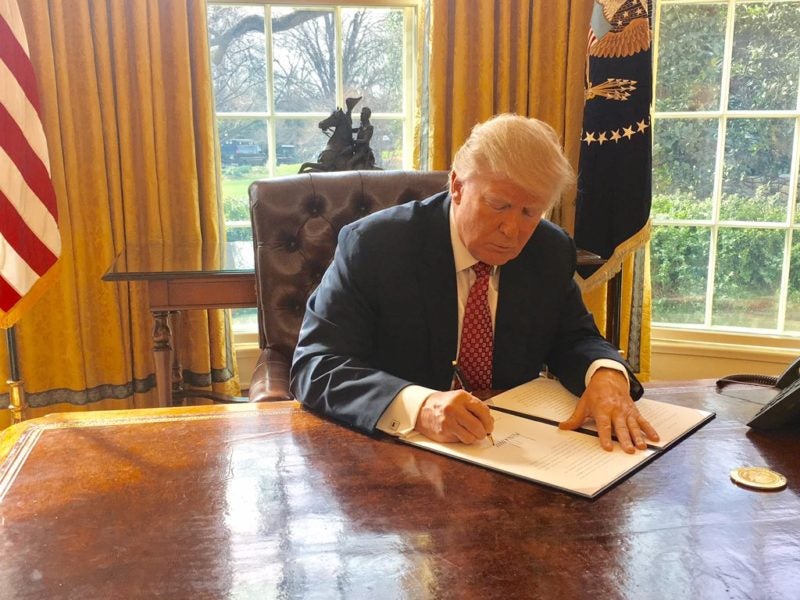Latest News

President Donald Trump signing Executive Order 13780. Photo: Wikimedia.
President Trump’s executive order to revive the National Space Council has already been written, said Robert Walker, former chairman of the House Science Committee, at a panel earlier this week. “It’s all set to go,” he said. “I think it’s imminent. I don’t know exactly when but everything is in place for it to happen.”
Walker’s statement came during the Ultra Low Cost Access to Space (ULCATS) Symposium in Washington, D.C., in the midst of a discussion on the potential of a space council to unlock new business initiatives in orbit. The panelists argued that by modernizing the regulatory environment, such an organization could help tighten the gap between the commercial, military and civil space sectors; increase the speed at which new technologies are developed; and most importantly, dramatically decrease the cost of launching into orbit.
Former President George H.W. Bush originally established the National Space Council in 1989, but the organization disbanded in 1993 due to internal conflicts between then NASA administrator Richard Truly and Vice President Dan Quayle. Although President Barack Obama promised to re-establish the council during his election campaign, those plans never materialized during his terms.
Consequently, former Speaker of the United States House of Representatives Newt Gingrich, who delivered a keynote at the symposium, pointed a finger at the government for failing to nurture the U.S.’ commercial space prospects. “We’ve been stuck now literally for a quarter century in a series of bureaucratic decisions,” he said. “It inhibits your ability to move into a dynamic, exciting, open-ended future.”
Gingrich however believes that “people wealthier than countries,” such as Blue Origin Chief Executive Officer (CEO) Jeff Bezos and SpaceX CEO Elon Musk, have the power to shift the dynamic, leveraging their capital to fund next-generation capabilities such as fully reusable rockets. “Unless the lobbyists figure out a way to cut off the development by Musk and Bezos, the fact is the old system will become obsolete,” he said.
 Ret. Lt. Gen. David Deptula. Photo: U.S. Air Force. |
 Robert Walker, space policy adviser for Donald Trump’s presidential campaign. Photo: Wexler Walker. |
 Lt. Gen. Steven Kwast, commander and president of Air University. Photo: U.S. Air Force. |
According to retired Lt. Gen. David Deptula, the speed at which government programs operate simply pales in comparison to the rate of innovation in the private sector. “Most of the advancements in technology over the last quarter century or so have come from commercial industry innovations. Commercial enterprises are free from the shackles of the byzantine acquisition policies that have become a hindrance to innovation,” he said. While Deptula said there is no chance the Department of Defense (DOD) will change its acquisition process anytime soon, he urged the agency to find new ways to take advantage of commercial innovation.
Walker said the government is taking the first steps to do just that, referring to SpaceX’s launch that morning of a spy satellite for the National Reconnaissance Office (NRO). “Innovation is taking place in the commercial community and it’s now being recognized by the national security community that this is a place where they need to play in order to be effective going forward,” Walker said. “I find it extremely exciting that we are seeing the Public-Private Partnerships (PPPs) begin to infiltrate the entire scope of our space venture.”
The panelists agreed that part of the benefit to leveraging PPPs is that companies can streamline the process of developing a new technology. Moreover, because government agencies are involved in the process every step of the way, they’re more likely to use the technology once it becomes a reality. SpaceX Senior Vice President Tim Hughes highlighted the U.S. Air Force’s Evolved Expendable Launch Vehicle (EELV) program as one salient example. “PPPs can help to acclerate things that may be slower in development in the absense of government money. When you look at the EELV program, for instance, it took the Air Force quite a while working with SpaceX to get the level of insight they were looking for into the Falcon rocket to be able to purchase operational missions. When you have PPPs speaking to things like reusability you accelerate that adoption model more quickly because the government understands what you are doing,” he said.
Ultimately, the panelists seemed to believe that PPPs are one of the most effective paths toward achieving ULCATS, which they overwhelmingly agreed is a necessary element for further advancements in space technology and business. With the advent of innovations like reusable boosters, the industry is edging ever closer to the next stage of its evolution: having hundreds (and eventually thousands or millions) of people living and working in space.
“Today what we’re actually doing is deploying assets to space that do work for us … but we are not really operationalizing space. We are not going up there and doing the work ourselves,” Kovacs said. “ULCATS would give you the ability to have humans working in space.” According to Kovacs, ULA estimates that in approximately 30 years, humans will be conducting $2.7 trillion worth of economic activity up in orbit.
However, Lt. Gen. Steven Kwast, commander and president of the U.S. Air Force’s Air University, believes that estimate is too conservative. “We never understand how quickly the future crashes on our shores. We always predict wrong. There’s about $100 billion in resources for every human being on Earth sitting very near to our planet, accessible to us. When you have that kind of marketplace out there the titans of innovation are going to go after it,” he said.
Get the latest Via Satellite news!
Subscribe Now